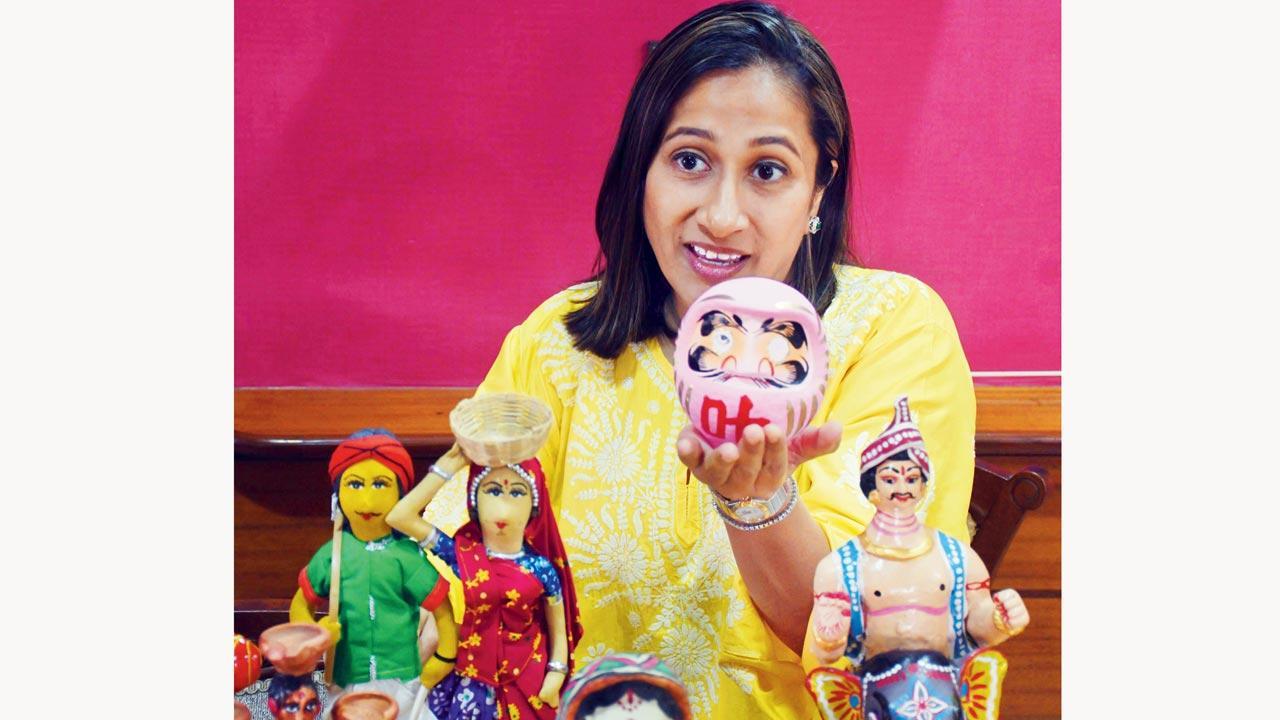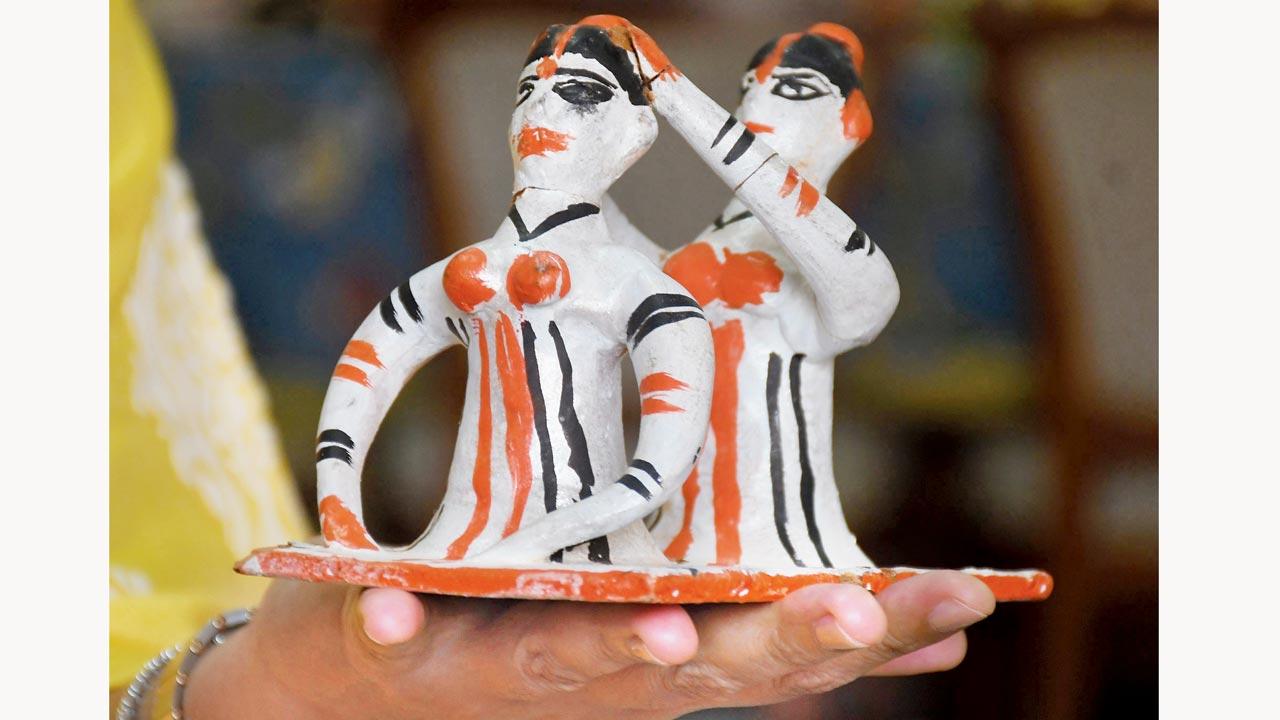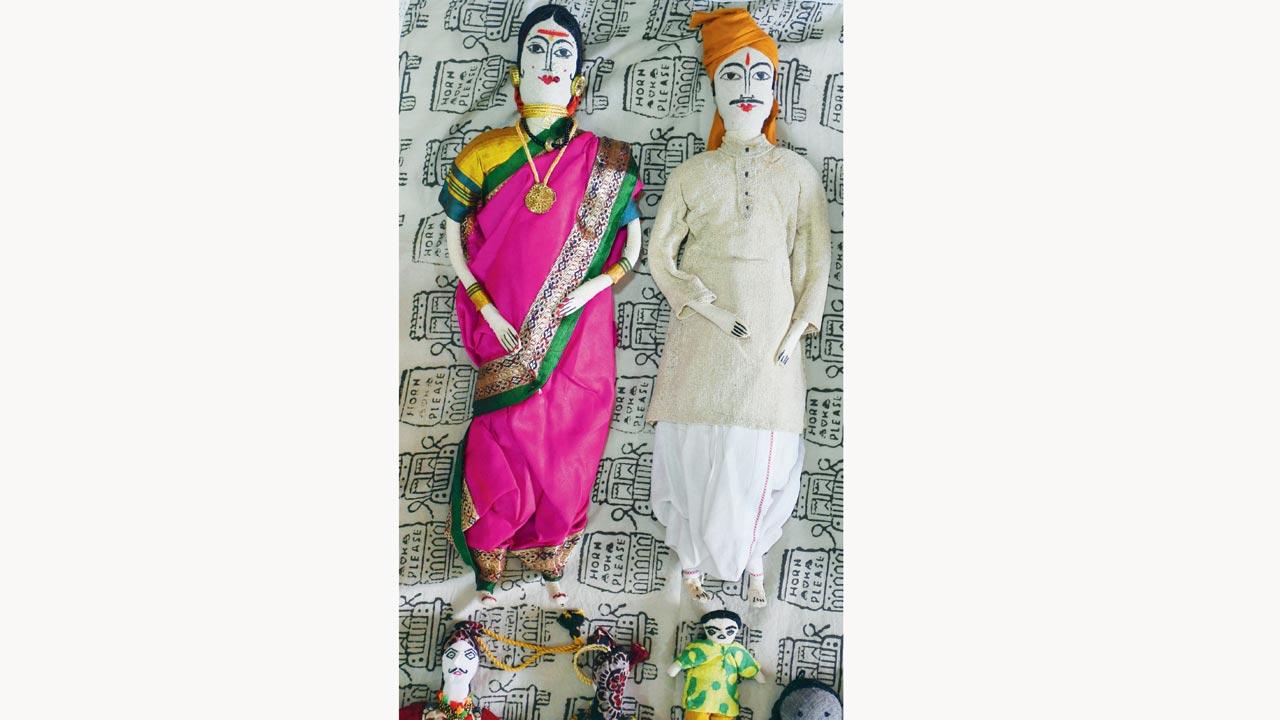A financial consultant is a passionate documenter of indigenous dolls and hopes to have her own museum

Neha Parekh holds a Japanese Daruma doll, modelled after Bodhidharma, the founder of the Zen tradition of Buddhism. The dolls are seen as a symbol of good luck and perseverance. Pics/Ashish Raje
A round pink doll of a man with bushy brows and a big curled up moustache catches our attention, largely because it has one eye filled and another one blank. Seeing our puzzled faces, Neha Parekh explains: “It is a Japanese Daruma doll. When you buy it, both the eyes are empty. You make a wish and fill the left eye and when the wish is fulfilled, you fill the right eye.” Parekh bought them a couple of months ago when she visited Japan. These traditional dolls are modelled after Bodhidharma, the founder of the Zen tradition of Buddhism, and are seen as a symbol of good luck and perseverance, making them a popular gift.
ADVERTISEMENT
We are sitting in the drawing room of Parekh’s Prabhadevi home. Every table has been taken over by dolls and masks. Some are even on her walls, including a deep blue Bhairav mask. A management student who works in the family’s chartered accountancy firm, Parekh can’t put a finger on when the world of dolls sparked her curiosity.
 These Kanthalia dolls are made by the potter community of Murishabad, West Bengal. The artisan Sadhan Pal is the last in his village to sustain this art form
These Kanthalia dolls are made by the potter community of Murishabad, West Bengal. The artisan Sadhan Pal is the last in his village to sustain this art form
“[Being Rajasthani,] we have seen palaces and museums since we were young,” she says. “Besides, one of my father’s clients ran an auction house in Mumbai. Subconsciously, we have been consuming art in various ways.” Parekh also dutifully makes a monthly pilgrimage to Dr Bhau Daji Lad Museum, Jehangir Art Gallery, Chhatrapati Shivaji Maharaj Vastu Sanghrahalaya, among others. She is also a collector of coins and postal stamps, among other memorabilia.
Her collection of 500 dolls, figurines and masks has largely been put together over the last five years, mostly handpicked from across the country and world, or sourced directly from artisans. There are simple Kanthalia dolls—wearing bindi and sindoor, and their hands and lips stained red—sourced straight from the potter community of Kanthalia in Murshidabad. They depict scenes from daily rural life: A woman sitting by a quern-stone, hand-grinding grain; another plaits a young girl’s hair; still other has a toddler spread over her lap as she massages him.
 A pair of Maharashtrian cloth dolls, where the woman is wearing a nauvari saree
A pair of Maharashtrian cloth dolls, where the woman is wearing a nauvari saree
“These are made by Sadhan Pal, the last in his village to know this art form,” Parekh informs. “I was looking for Kanthalia dolls, and found his number, but there was a language barrier. He doesn’t know anything but Bangla, which I don’t speak. He figured I wanted to talk to him about his work, and caught hold of a neighbour who helped us communicate. He sent me some dolls, but didn’t have materials to pack them carefully. So, he sent them to me in pieces and I pieced them together with glue,” shares Parekh. The art form goes back a 100 years. “He couldn’t explain the significance of colours but I was told that earlier, the colour black would be extracted from kerosene.”
Her collection also includes masks, like the SaraiKela Chhau worn by Chhau dancers of Jharkhan, the Bhaona from Assam and the Gomira from West Bengal. “Gomira is worn by male dancers,” Parekh tells us, “and it makes them breathless. But they say the village deity, Gram Chandi, empowers them to continue their performance.” Earlier this month, Parekh displayed her collection at the Jehangir Art Gallery and at the Indian Council For Cultural Relations in March. She is speaking to the consulates of a few countries to host more of these in the future.
“To be honest, it [collecting the dolls] was a 10-year plan, but the pandemic gave me so much time that I could do it in five years,” she says as we go through notebooks with detailed notes about various artforms, museums, entry tickets and family lineage. “My younger sister Ridhi and I take long guided tours centred around museums and meeting local artisans,” she says. They return with a lot of artwork from the artisans. “We always carry bubble wrap, scissors, and newspapers,” she laughs.
An extensive collection like theirs is rare, especially when one lives in a city like Mumbai where space is a luxury. Parekh agrees. “Thankfully, our parents never complained. Even our television room is no longer in use as it is full of boxes,” she says. Their home is going to be renovated soon, and a dedicated room will be carved out for their collection. “For now, besides keeping a few dolls and masks on display, we pack everything else carefully. Every month, I take all of them out, clean them, put them under the sunlight and let air pass through them, otherwise they won’t survive.”
What’s next? A 15-day trip to Madurai, Chettinad and Tanjore, and a stop at Sawantwadi in Sindhudurg before that. “Eventually, I want to have my own museum,” she says. “I want to conduct guided tours, especially for children, where I could teach them how they too can document art.”
 Subscribe today by clicking the link and stay updated with the latest news!" Click here!
Subscribe today by clicking the link and stay updated with the latest news!" Click here!







